The amazing Montserrat mountain range which is located inland about 50 km from Barcelona was one of our favorite places in Catalonia. These mountains that surround the Montserrat monastery have really atypical shapes that reminded us a little bit of Mount Hua in China.
Honestly, we loved hiking on the paths of this range, through these rounded peaks shaped by millions of years of erosion… and we hope that this little guide will also inspire you to come and wear out your soles here. All right, let's get started!
The Montserrat mountain range
First of all, Montserrat is a rather impressive mountain range which rises abruptly North-West of Barcelona and which rises to 1236m in height. With the van, we arrived from the small town of Vic and we saw the silhouette of the massif from already quite far. We can say that it bears its name well since Montserrat can be translated by "Mountain in sawtooth".
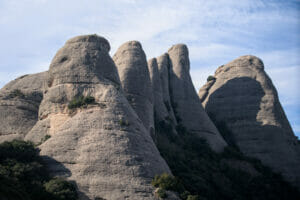
But it is only the following day when we arrived much closer to the mountains that we realized the relief is certainly abrupt (with cliffs of more than 300m), but that the peaks are in fact rather rounded. This can be explained by a few million years of erosion which have shaped this mass of conglomerate to give it its present singular shape. Moreover, the Montserrat mountain range is protected and has been declared a natural park by the Catalonia province since 1987.
So as far as we are concerned, what first drew us to Montserrat was the idea of hiking and discovering these landscapes shaped by the elements. And if you are a climber, it is also one of the most popular places in Catalonia for climbing with something like 5000 ways. There's plenty of fun to be had!
The Montserrat monastery
However, if Montserrat is very famous in Catalonia it is rather for its monastery which is home to the famous Moreneta (one of the rare black virgins of Europe), patron saint of Catalonia. So we are not going to repeat here the legend which tells the discovery of the virgin (we let you discover that in the museum in Montserrat), but the fact is that the Benedictine abbey of Montserrat became an important place of pilgrimage since the Middle Ages.
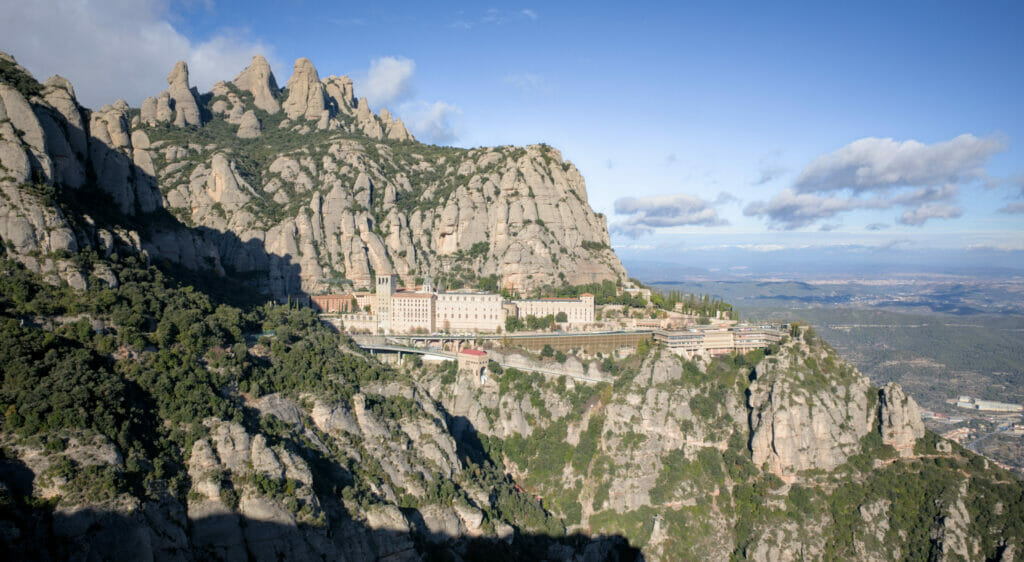
On our side, we did not come to Montserrat to make a religious pilgrimage 😉 … But we have to admit that we were nevertheless curious to discover this famous monastery built in the heart of the mountains, at the foot of an impressive cliff.
Our guide to hike the Montserrat natural park
We will start with the main reason that brought us here: hiking! There are a lot of possibilities to hike in the area and besides the natural park of Montserrat suggests 4 "official" hikes that can suit hikers of all levels. On our side we preferred to create a variation which combines these 4 routes to discover all the facets of these mountains.
Here are the 4 hikes that you will find on the signs of the Montserrat Natural Park:
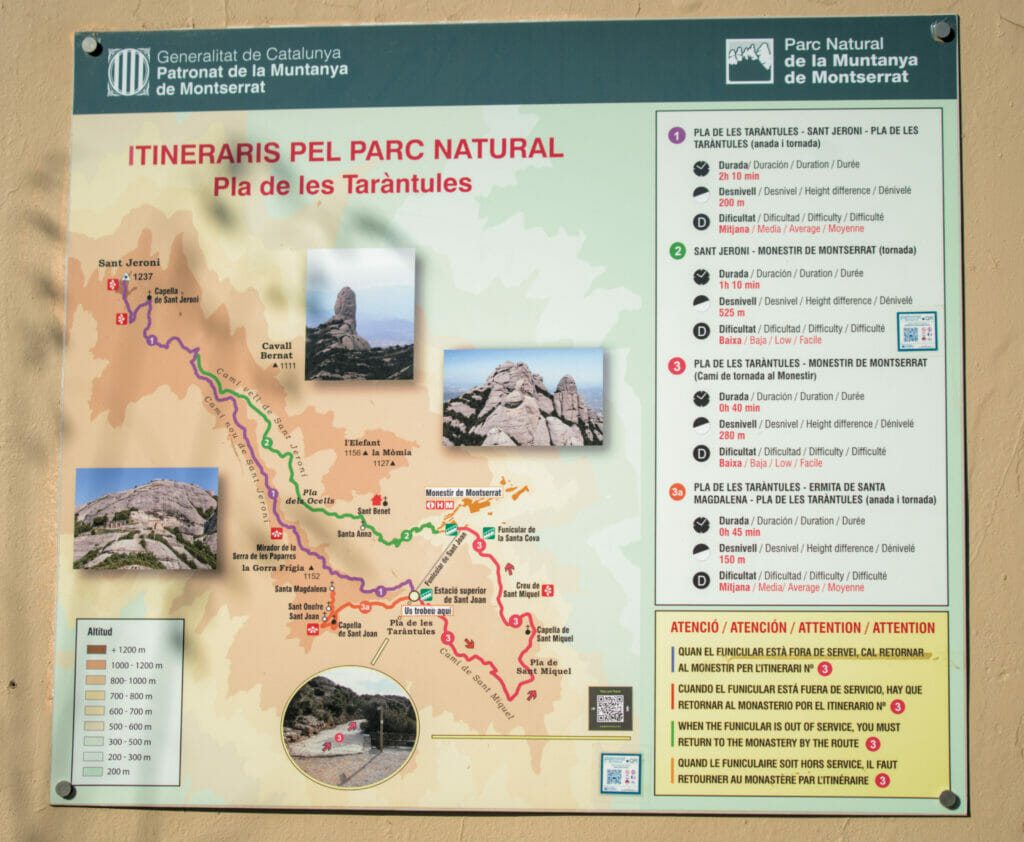
- Hiking up to Sant Jeroni from the funicular top station: It is the purple path on the map which is about 3,7kms for 300m of d+. This path allows you to climb to the top of the highest mountain of the park which is Sant Jeroni which culminates at 1237m.
- Hiking down from Sant Jeroni to the monastery: The green path on the map (3,9kms for about 450m of d-) that will allow you to hike down from Sant Jeroni summit to the monastery.
- Hiking down from the funicular top station to the monastery: The red path on the map (3kms for 250m of d-) that allows you to hike down from the top of the funicular (or up) passing by the magnificent cross of Sant Miquel.
- Hiking up to Santa Magdalena from the funicular top station: Orange path on the map (250m of d+ approximately for 1kms) that goes up to the top of Santa Magdalena.
As you can see, the distances and elevation changes are not huge either! So we decided to combine all these hikes to make a nice loop (11,1kms and 730m of d+-) starting from the monastery and discovering most of the Montserrat range by finishing with the visit of the monastery. We share with you the map of the hike below before showing you all this in more detail.
Map: If you want to have the map with you (on your hiking app, maps.me or on your connected watch), you can download our track from AllTrails. To access the 30+ export formats, simply create a free account.
We arrived at the parking of the Montserrat monastery early in the morning (we will explain you below the different ways to arrive to the monastery). Our idea was to make our hike and to visit the monastery at the end of the day if we still had the time and the energy. Just gone out of the van that we have already a fantastic view on Catalonia below (we even guess the city of Barcelona in the distance) and the monastery in the cliff side.
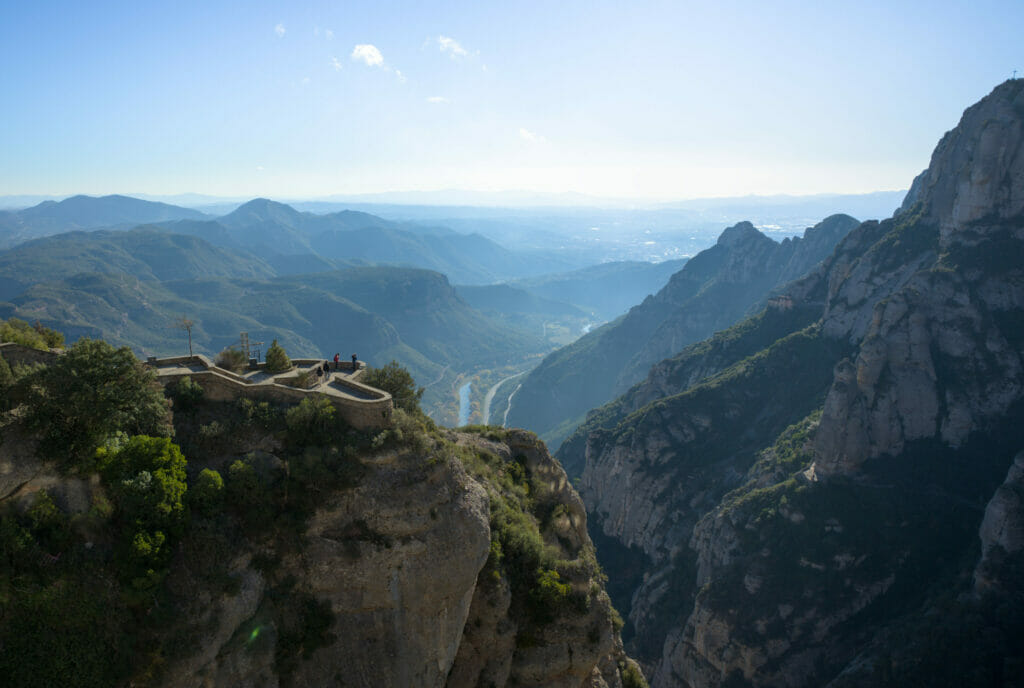
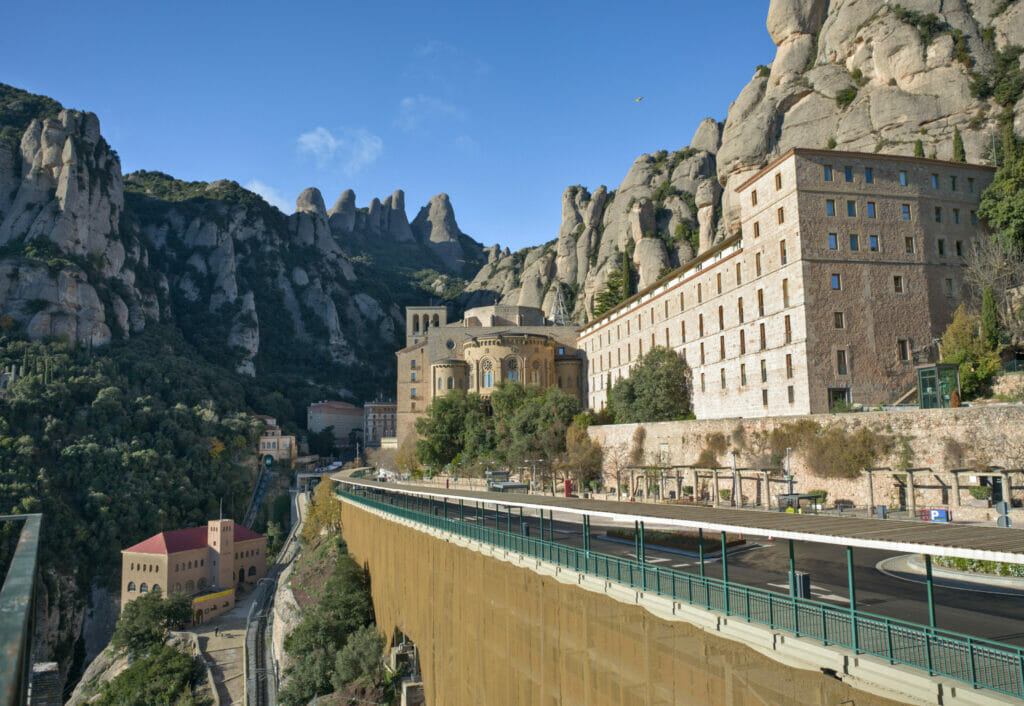
So we pass in front of the monastery without lingering too much to go up on the left following the Sant Miquel way (red trail on the picture). We hike up until we arrive at a first crossing to go down again to reach the cross of Sant Miquel which offers probably the most beautiful panorama on the monastery and the Montserrat mountains (we can even see the snowy Pyrenees in background). Judge for yourself:
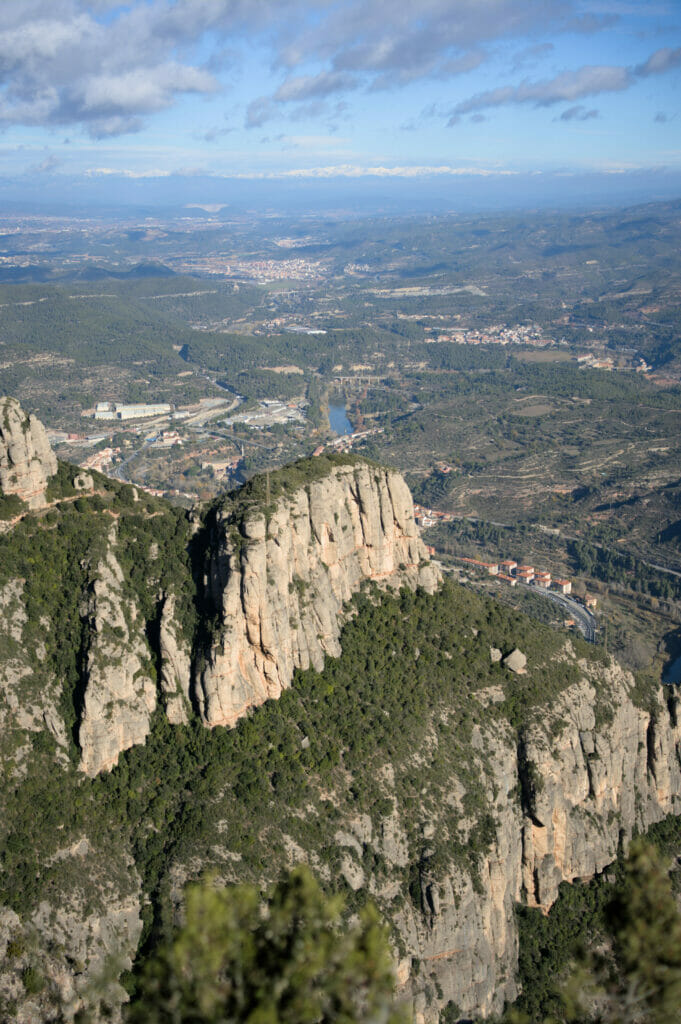
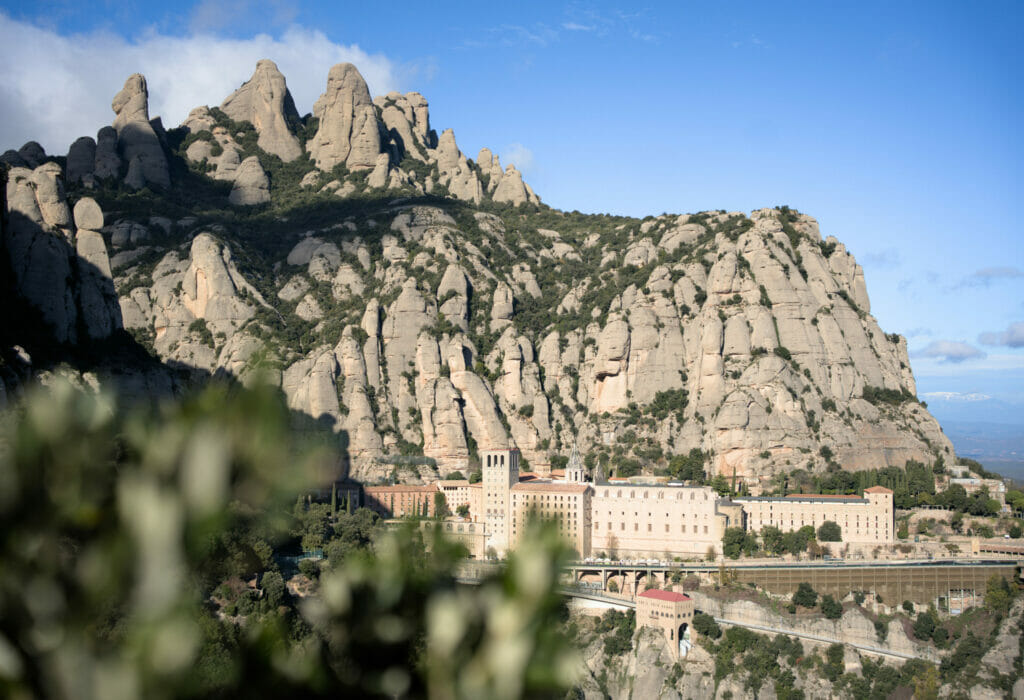
OWe go back to the crossing to continue our ascent towards the upper station of the Sant Joan funicular. We make a small break on a bench at the Sant Miquel's chapel which is just along the way. A sign indicates that we have 20 minutes of walk to the top of the funicular. And indeed, 15 minutes later, we arrive on a small promontory just above the upper station which offers us a magnificent view on all the Montserrat massif.
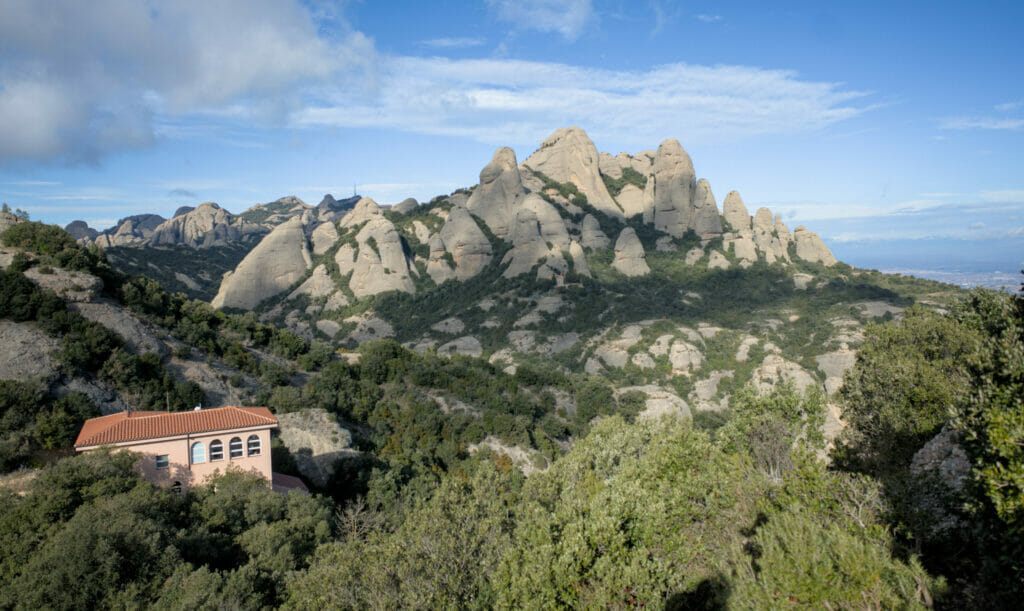
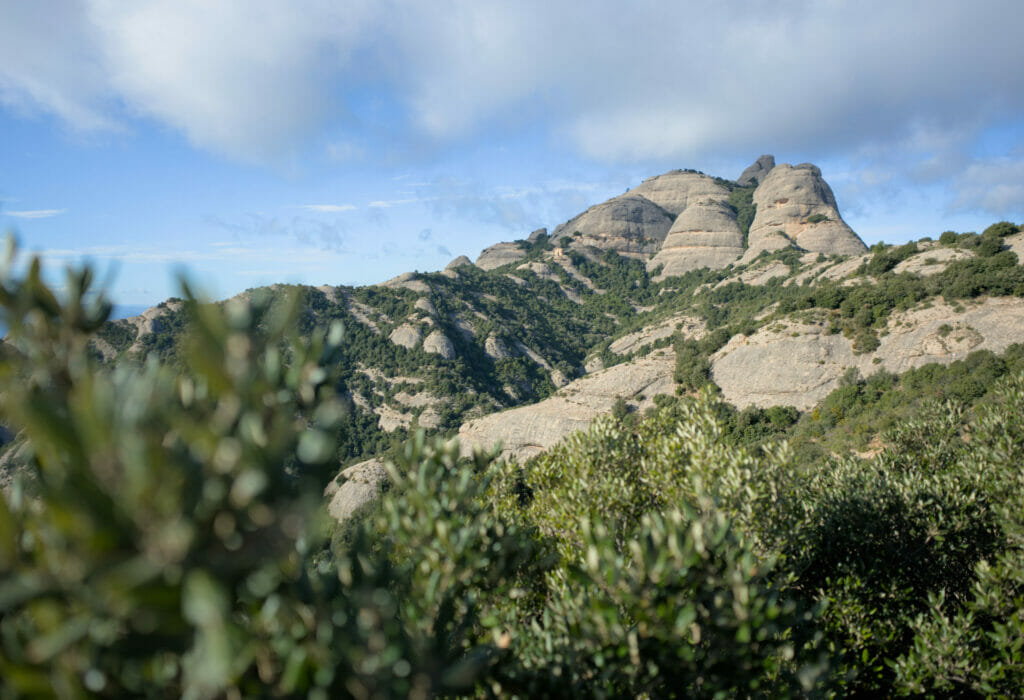
From the funicular, we turned left to go up towards the small chapel of Sant Juan. We decided not to make the small detour towards the Santa Caterina and Sant Juan chapels (our hike was already long enough as it was) and to hike up directly to the summit called "miranda de Santa Magdalena". After a very steep part, we pass in front of the rests of the Santa Magdalena's chapel to continue to climb until the summit. Even if there was a lot of wind (cf the photo of Winchy who protects himself behind a bush), we have a superb view over the whole range and we really recommend you to pass here.
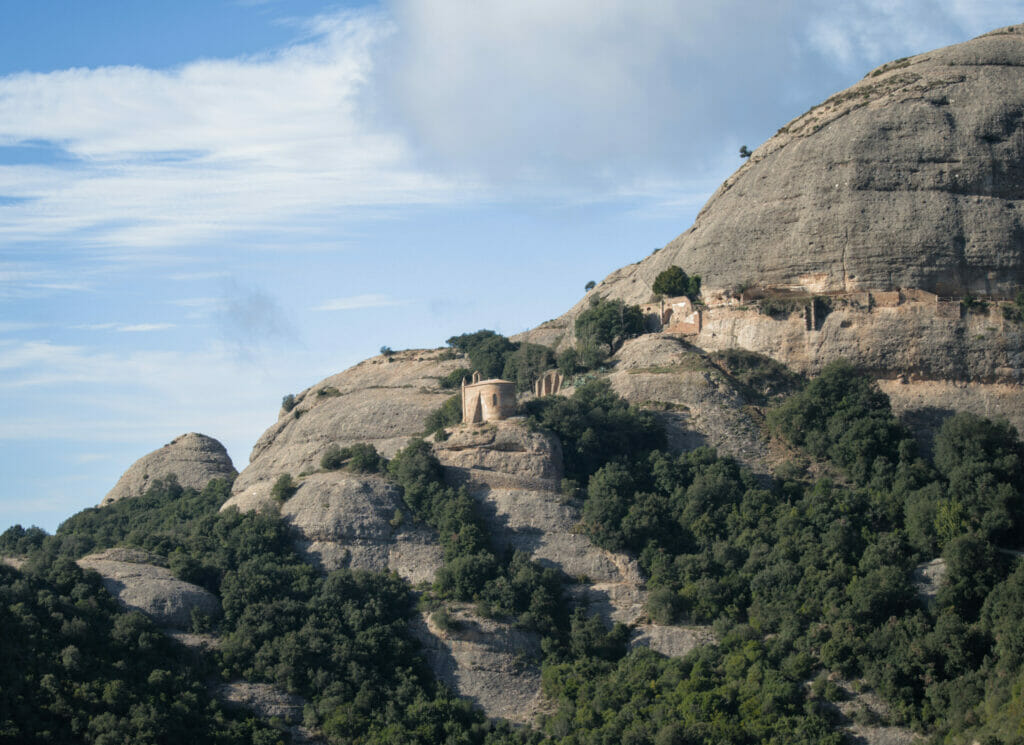
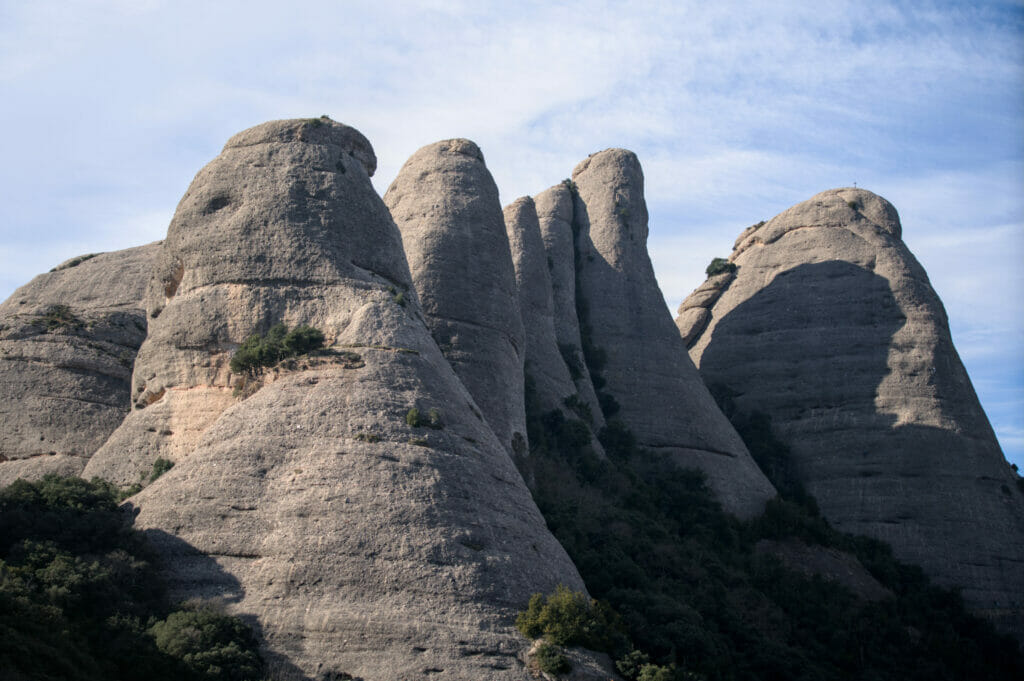
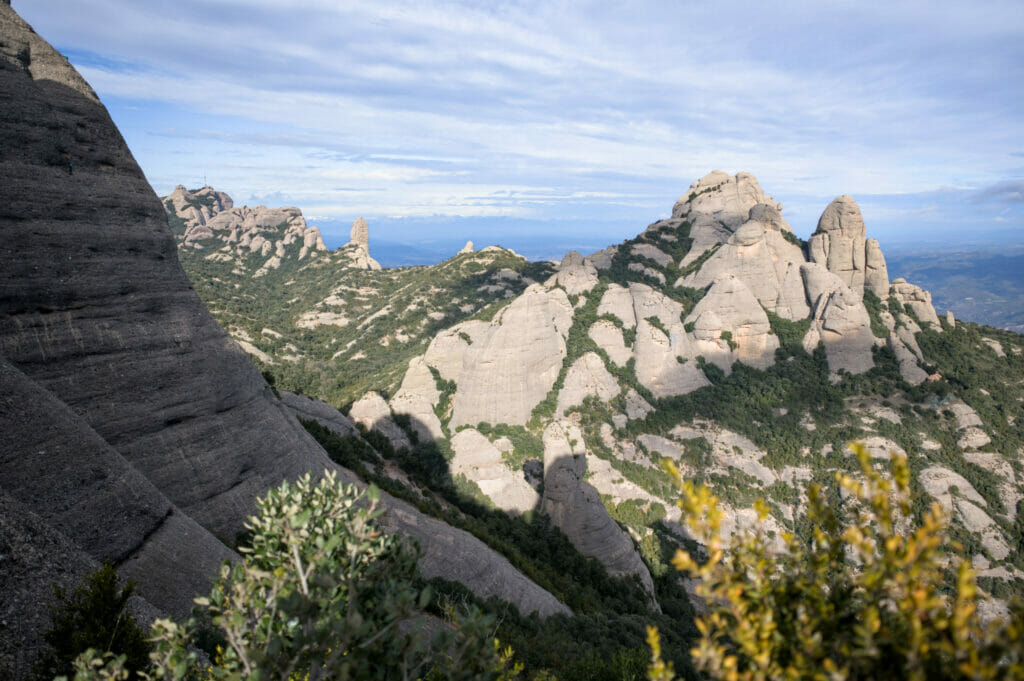
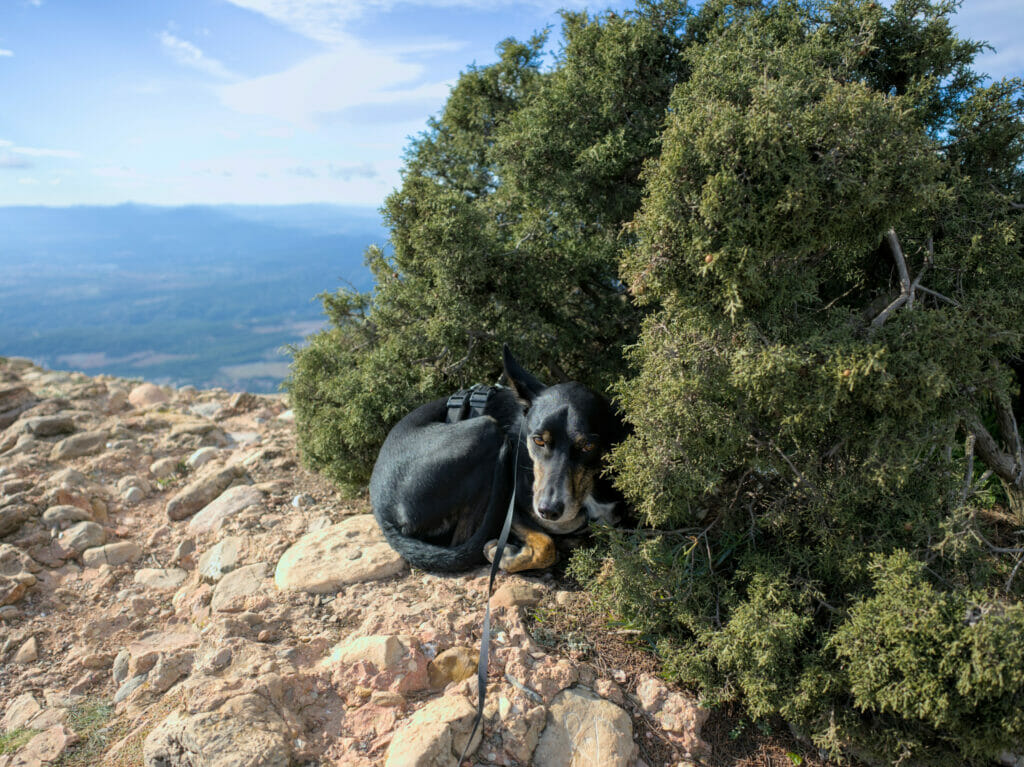
Going back down, just below the remains of the Santa Magdalena chapel, we turn this time to the left to take some very steep stairs overlooking the monastery and joining the path No. 1 (the purple one on the picture). This part is really nice! We first overlook the monastery to continue in the heights towards Montserrat's highest peak: Sant Jeroni (1237m).
Unfortunately for us, the weather is getting cloudy and the wind is blowing harder and harder. Moreover some renovation works prevent us from hiking the last few meters to the top… It's not a big deal, the view on the whole massif is still very beautiful and with this wind we wouldn't have stayed for long anyway!
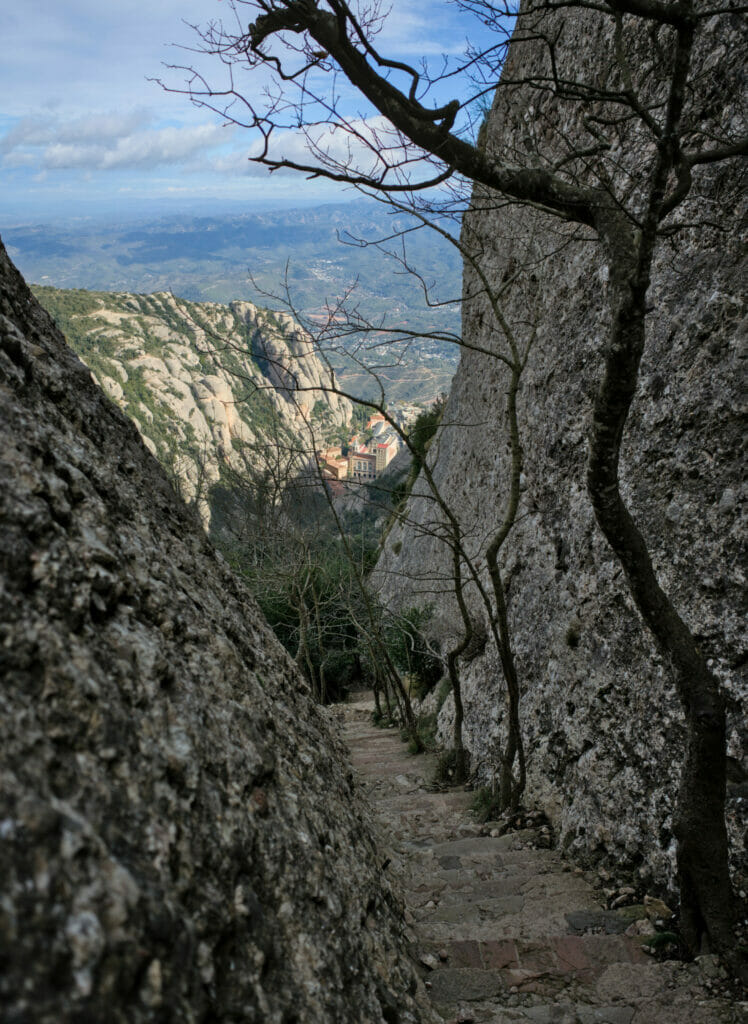
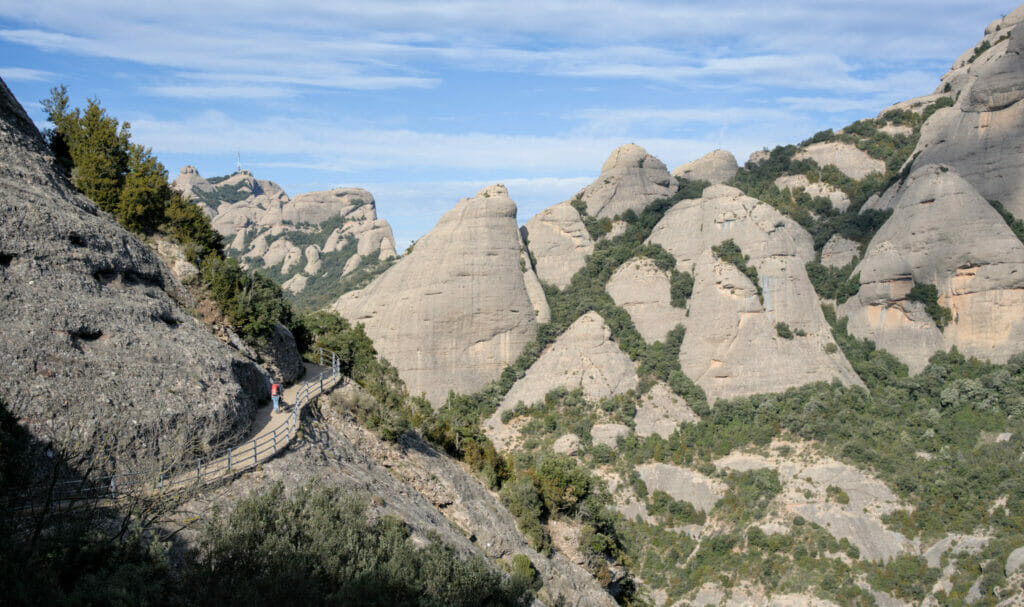
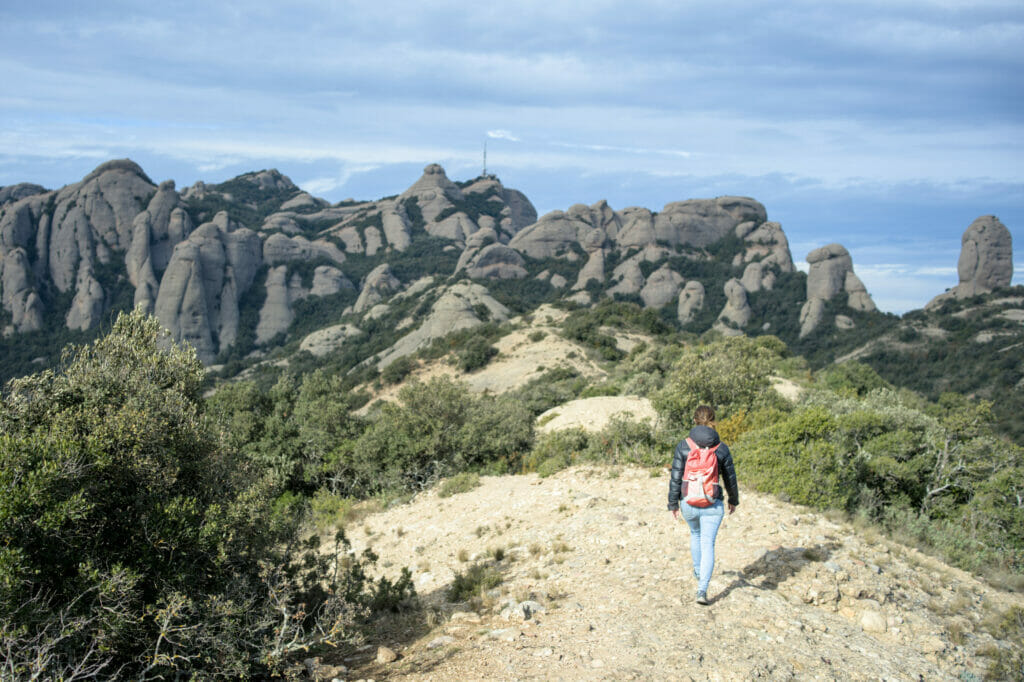
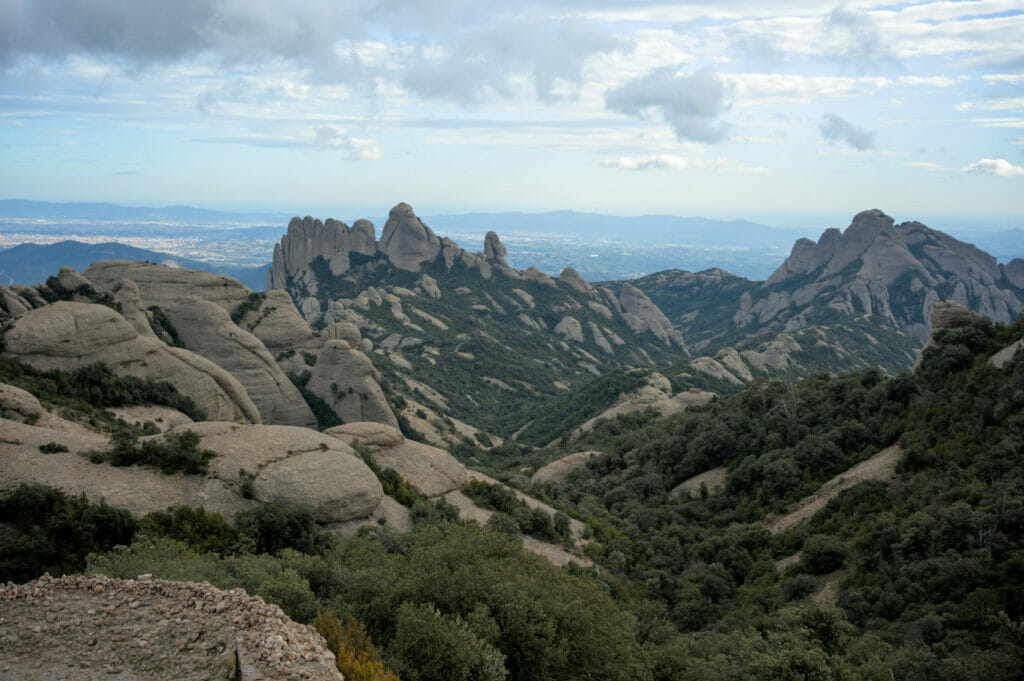
At last, we "only" had to hike down again to the monastery. We pass this time in front of the small Sant Jeroni's chapel then we turn to the left in the forest to follow the path No2 (in green on the picture). It takes a good hour from the chapel to complete the loop and return to the monastery.
So we were certainly a little bit tired when we arrived! But we still found the motivation to leave Winchy in the van and visit the Montserrat monastery.
Things to see and do at the Montserrat Monastery
So there are in fact quite a lot of things that you can visit if you come to the Montserrat monastery (and no we didn't do everything after that good hike we already did 😉 ):
The basilica and the black virgin of Montserrat
Well, we will confess, even if we rather came for hiking, it would have been a pity to miss the visit of the magnificent basilica of Montserrat and its famous Moreneta ( all the more that the access to the basilica and to the black virgin is free 😉 ).
The basilica is reached from the beautiful Santa Maria plaza, which you have to cross to reach the square of the basilica. The square is absolutely gorgeous with its black and white marble floor that leads the visitor to the magnificent front façade of the basilica.
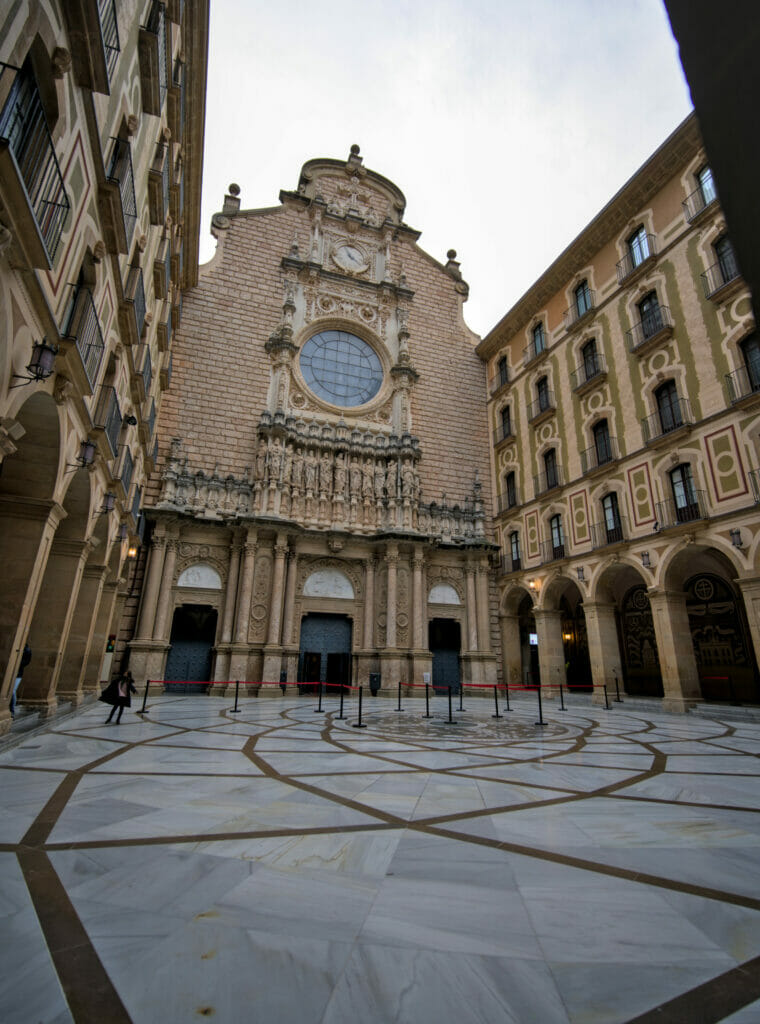
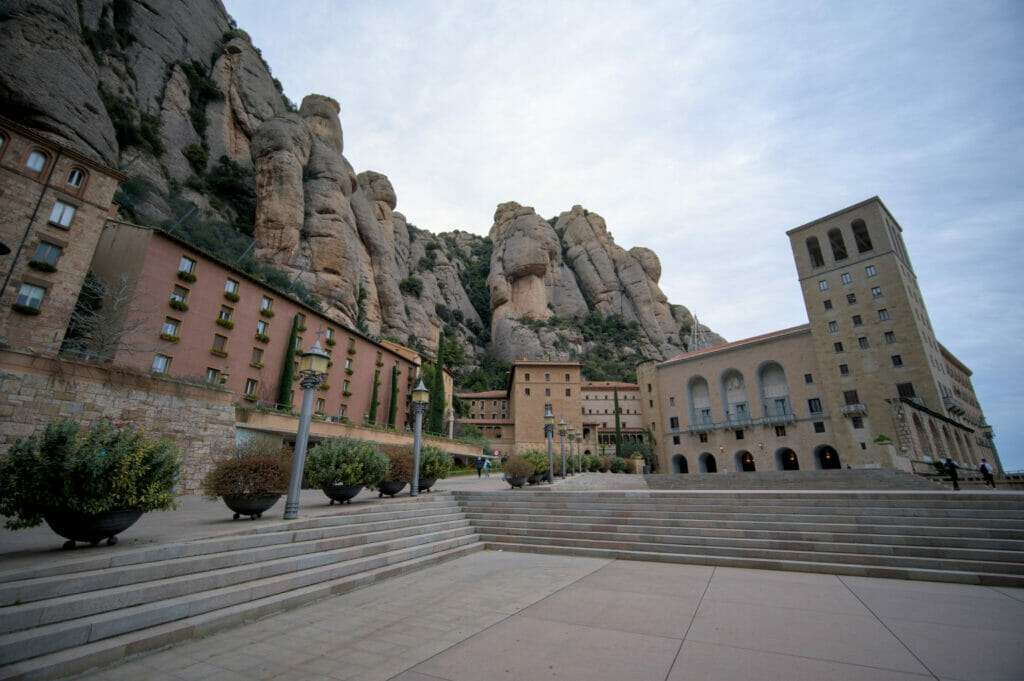
Here you will have the choice to enter the basilica through the central door or to access the chamber of the black virgin on the right (be careful, there can be a very big queue to see the Moreneta). But if you arrive like us in the middle of December at the end of the day, you shouldn't have too much to wait 🙂
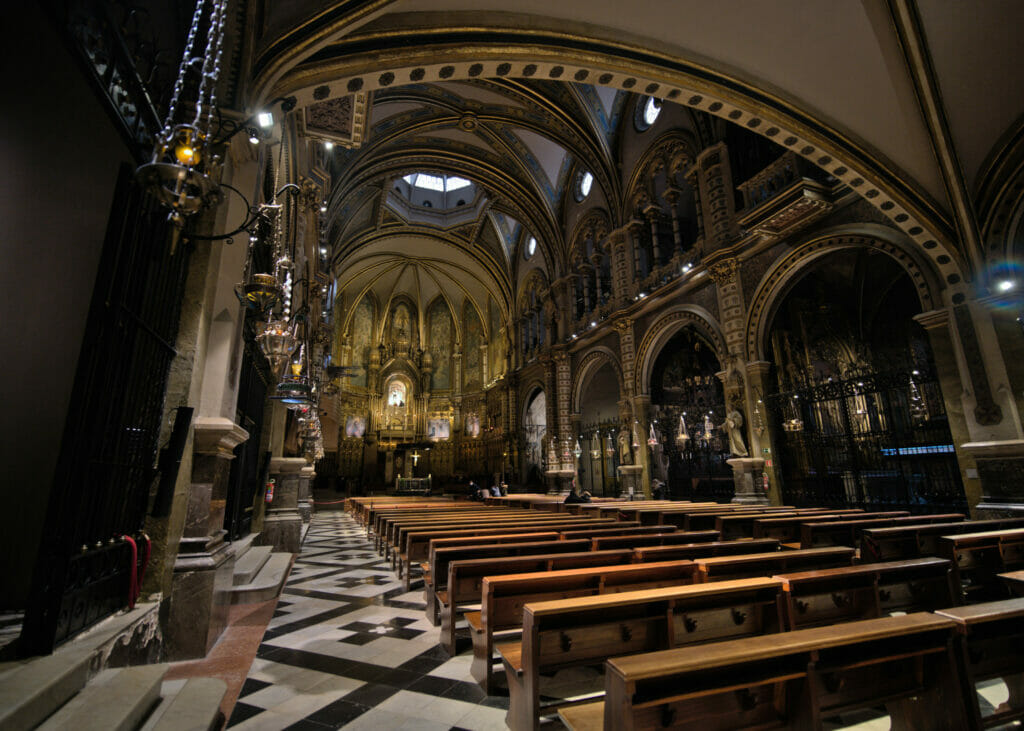
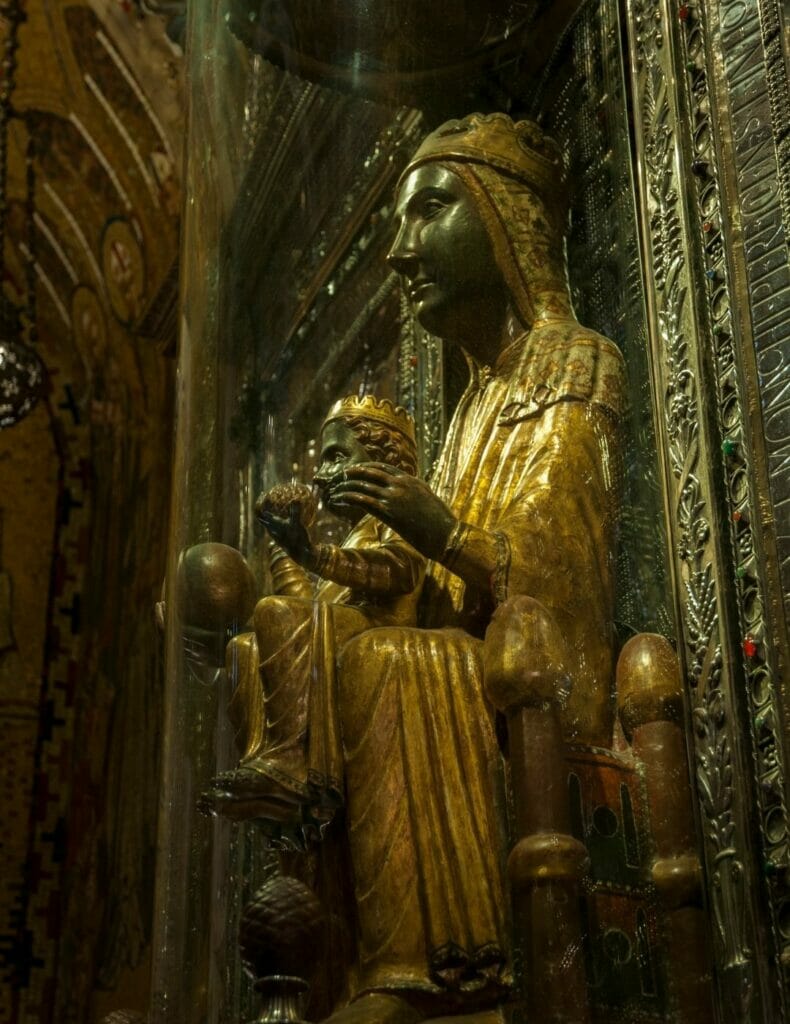
The Montserrat art museum
It's a bit strange because the Montserrat museum is in fact an art museum that has little to do with the monastery itself. This museum nevertheless contains more than 1300 different pieces (from Egyptian sarcophagi to artworks of artists like Picasso, Dali or Monet) in 6 permanent collections and 2 temporary ones.
In short as art museums are not our favorite thing, we haven't visited it. But if you're interested, you should know that the entrance costs 8€ (2,2€ more for the audioguide) and that the entrance is just in front of Santa Maria square
The audiovisual museum of Espai in Montserrat
If you want to learn more about Montserrat and its monastery, you should rather visit this museum. It contains different sections (Mountain, Presence, Monastery, Sanctuary and Culture) that will give you a complete overview of the monastery, including areas that are only accessible to monks.
At the end of the museum you can also watch a 15 minute video giving you a complete overview of a day at the monastery. During the video you can also listen to the Escolania de Montserrat, the world famous boys choir (if you missed one of the 2 daily concerts in the basilica).
So if you are interested in this museum, the entrance costs 5,5€ and you will find it in the staircase in front of the funicular of Cremallera.
The Sant Joan and Santa Cova funiculars
There are also 2 small funiculars that leave from the front of the monastery:
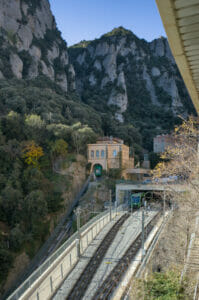
- The Sant Joan funicular: this is the one that allows you to go up to the mountains without necessarily needing to hike all the way up (either on trails 2 or 3 on the picture) as we did. So if you still want to discover the natural park of Montserrat without necessarily having time to make a big hike, this funicular is a good option.
- The Santa Cova funicular: This funicular goes down from the monastery in direction of the Santa Cova (place where the black virgin would have been discovered). From the lower station, you will only have to walk about 20 minutes to reach it. Basically the funicular allows you to save a part of the walk down (or up) to the Santa Cova that we unfortunately did not have time to visit.
How to get to Montserrat (from Barcelona or elsewhere)
Well, there is plenty of ways to come and visit the monastery and the mountains around Montserrat. But in short, either you have your own means of transportation (car, van or whatever), or you come with a tour, or you take the train and then the gondola or the cog railway to reach the monastery (you see, there are almost too many choices).
Get to Montserrat by car, van, RV...
Most people who come to visit Montserrat do so from Barcelona. If you have your own vehicle, you can drive up to the monastery where there is a fairly large parking lot with about 400 spaces (6,5€ for the day, 10,5€ for 3 days by car and 15€ for the day or 20€ for 3 days if you want to sleep on the mountain with your van or RV).
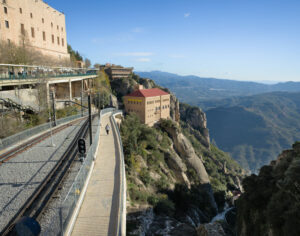
On the other hand we read on the web that during high season there can be a lot of people in Montserrat which can cause traffic jams on the road to Barcelona and quickly fill the parking lot of the monastery. So we recommend you to take a good look at google maps to see if there is a lot of traffic on the road going up to the monastery from Monistrol de Montserrat. If this is the case, we recommend that you take one of the other roads to the monastery, such as the one in the north (BV-1122) or the one in the west (BP-1103).
And if you are afraid of not finding a parking spot at the monastery, another interesting option is to park at the free parking of the Monistrol Vila train station (1000 spaces) and take the cog railway or at the Aeri de Montserrat station and take the cable car. You can find more details about parking in Montserrat on the official page.
As usual, if you need to rent a car for your stay in the Barcelona area, we always recommend that you take a look at the rentalcars website, which generally offers the best deals on rental cars. And if you're tempted to rent a van for your vacation in Spain, we've also written a handy guide that explains everything you need to know.
Get to Montserrat from Barcelona by train
If you are visiting Montserrat from Barcelona, this is probably the easiest way to get around. In fact you have to take the R5 line from Plaza Espanya station towards Manresa. Then you just have to stop either at "Aeri de Montserrat" and take the cable car or at "Monsitrol de Montserrat" and take the cog railway. Whether you stop at either stop, a one-way train ride costs 5.25€.
Go up to the Montserrat monastery by cable car
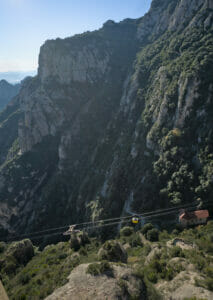
The cable car option is quite nice since the trip is really scenic. You will overlook the entire Llobregat valley and river as you ride the cabin up to Montserrat. To do this, you can either park or arrive by train at the Aeri de Montserrat cable car station. A one-way ticket will cost you 7,5€ and 11,5€ for the return trip.
Go up to the Montserrat monastery by cogwheel train
It's very easy to get there: just park or take the train to the Monistrol Vila train station (one stop after Aeri de Montserrat by train). Well, the official website of the cogwheel train seems to be out of order but it seems that the price of a one way ticket is 6,9€ and 11,5€ for a round trip.
So if you are planning to come by train from Barcelona, there are several combined tickets that may be worthwhile such as the Trans Montserrat and the Tot Montserrat. In our opinion, the most interesting of is the Trans Montserrat because it includes in one card:
- a ticket for the Barcelona subway system
- a return train ticket to the Montserrat cable car or cogwheel train
- Your choice of a return trip by cable car or cog railway (you must choose one of the two)
- use of the Montserrat funiculars as much as you like
- entrance to the audiovisual museum of Espai
You can buy this ticket easily on GetYourGuide and you will be able to pick up the card that you must show in the public transports at Plaza Catalunya, in front of El Corte Ingles
The Tot Montserrat ticket costs 20€ more and only gives you access to the art museum and a meal included… Honestly, if you can do everything included in the Trans Montserrat in one day, we think it's not bad. And if you absolutely want to have a look at the art museum, you can always pay your entrance without taking the meal included in the ticket.
Get to Montserrat by bus, with a tour
Well, so far we have told you how to prepare your visit to Montserrat if you come with your own vehicle or by public transport. But if you prefer, there are a plethora of organized tours that will usually bring you by bus from Barcelona to Montserrat for an excellent quality/price ratio
The advantage of an organized tour is that an English speaking guide is usually included (it's always nice to have a little more details about the monastery visit), the different entrances to the museums or to the funicular as well, there is even sometimes a meal or a tasting of local products included in the price.
In short, to have a look at the different possible tours to Montserrat, we suggest you to take a look at the 2 best sites in this matter: GetYourGuide and Civitatis
That's it for today! We hope that this small guide to visit Montserrat will be helpful and that you will appreciate this place as much as we did. Honestly, if you are on a roadtrip in Catalonia, it's a must. And if you are in Barcelona, it is really a great daytrip to take a breath of fresh air and get out of the city.
Pin it on Pinterest
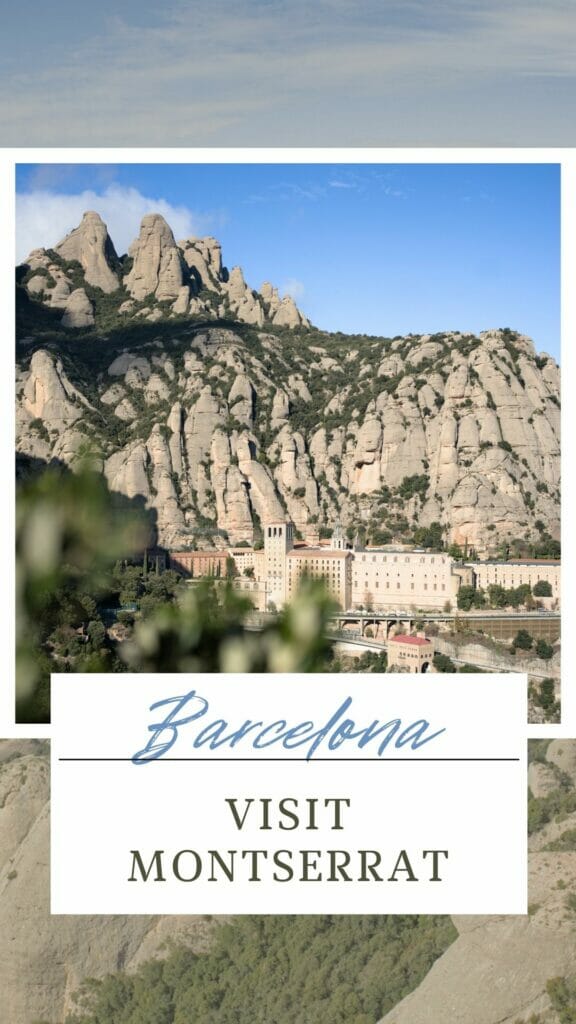
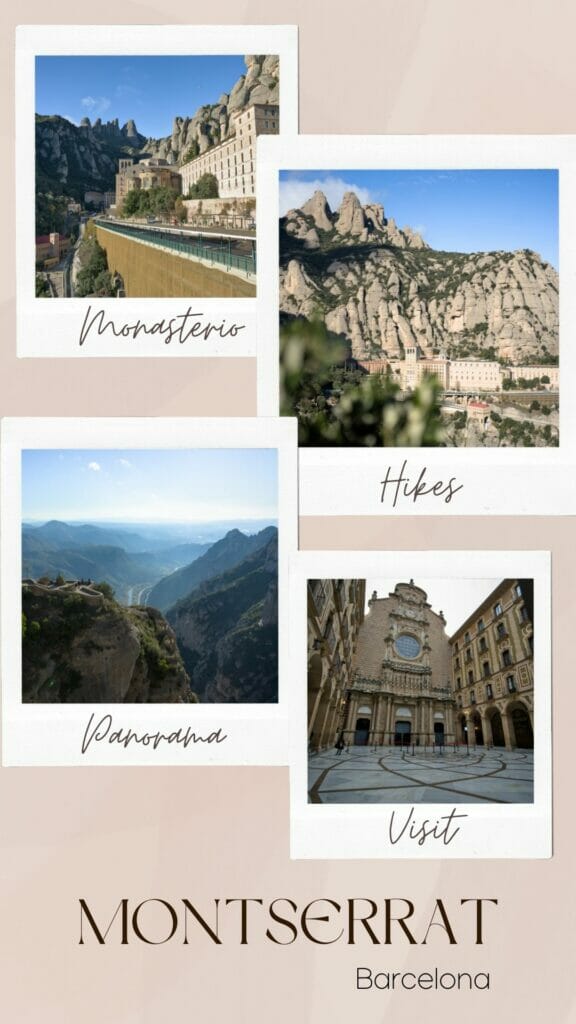
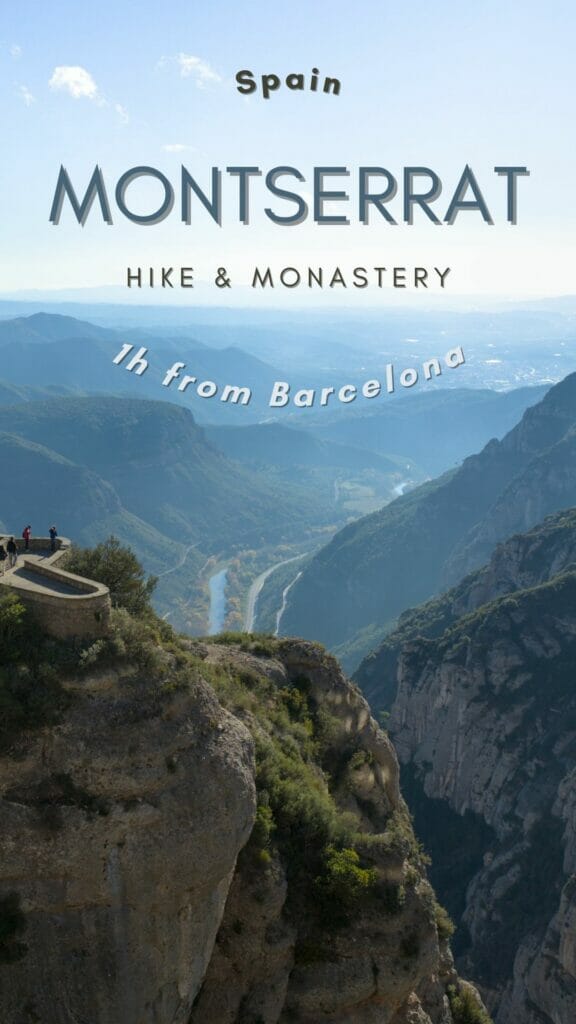
Note: If you rent a vehicle or buy a tour by clicking on one of our links, we will earn a small commission thanks to you (you won't pay a cent more). This supports us in creating this kind of free and independent content. Thank you for your support!
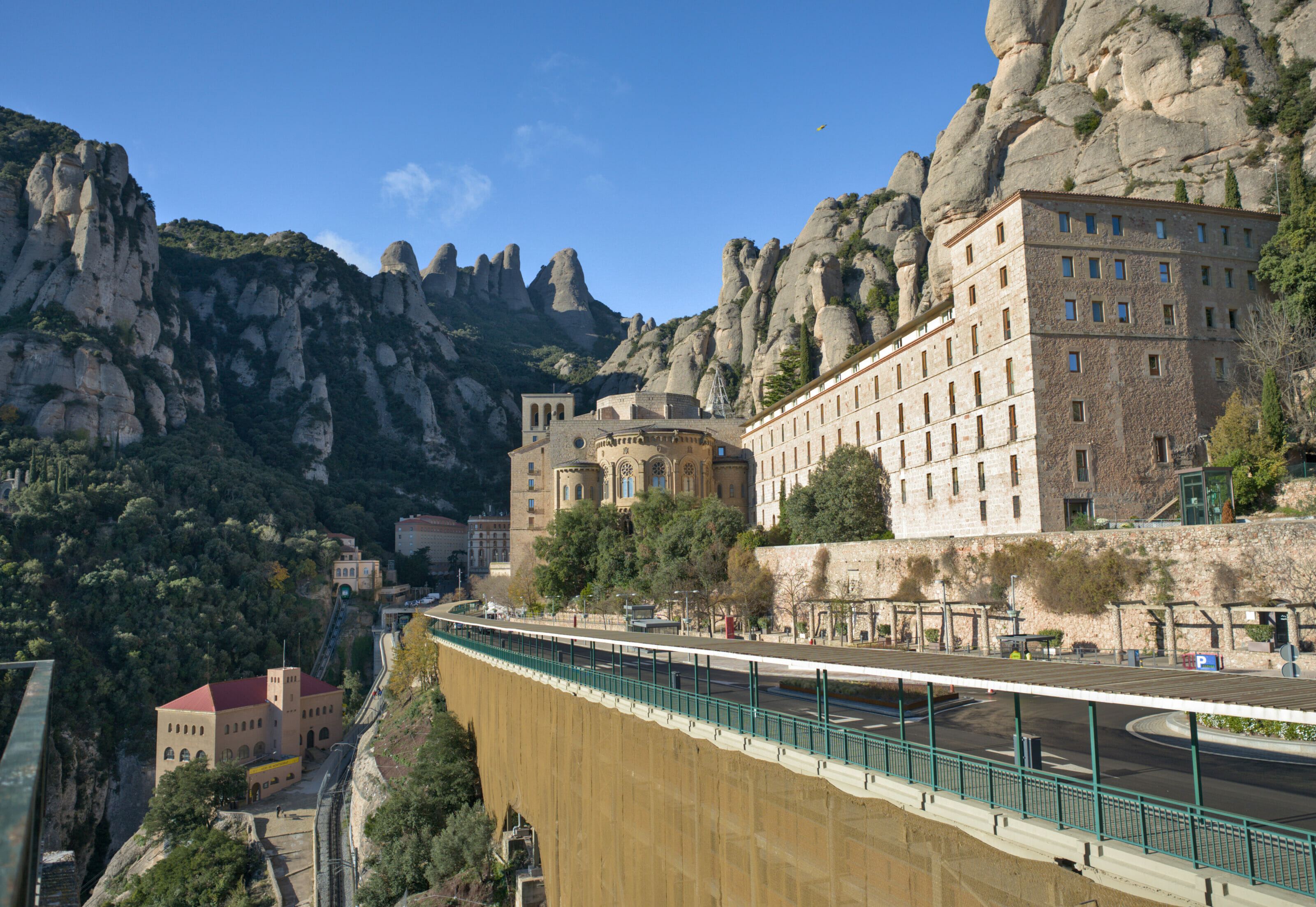
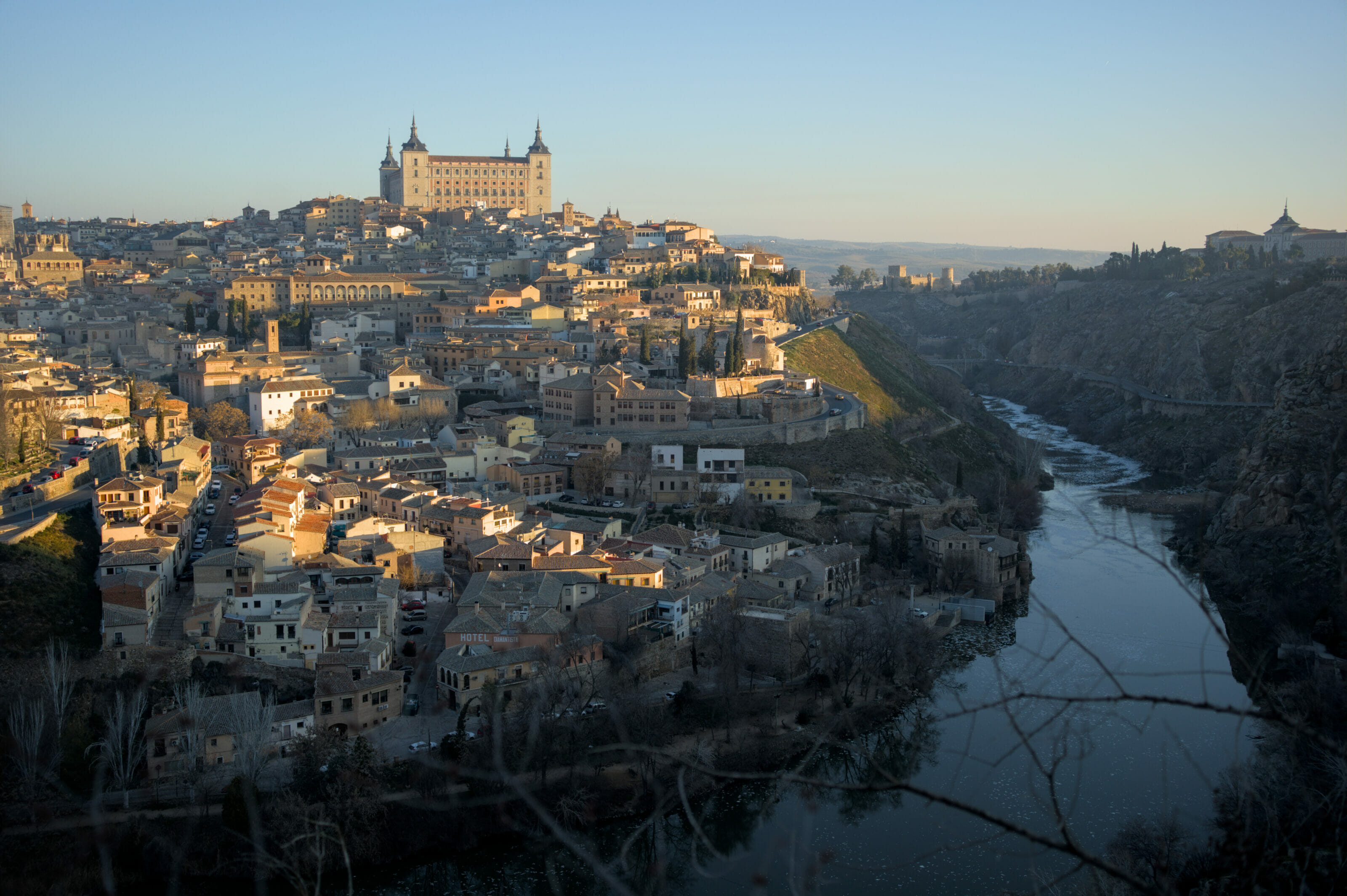
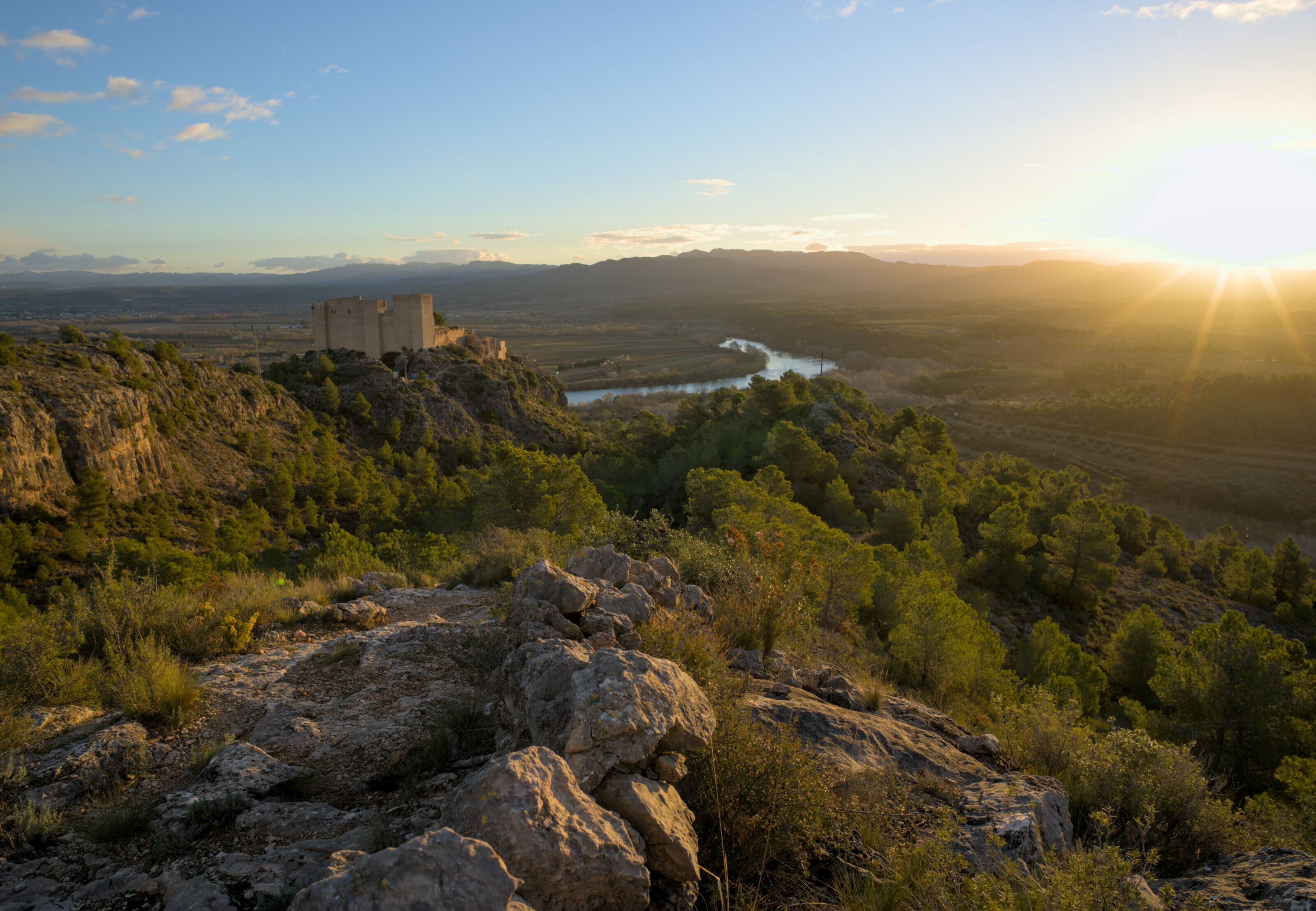
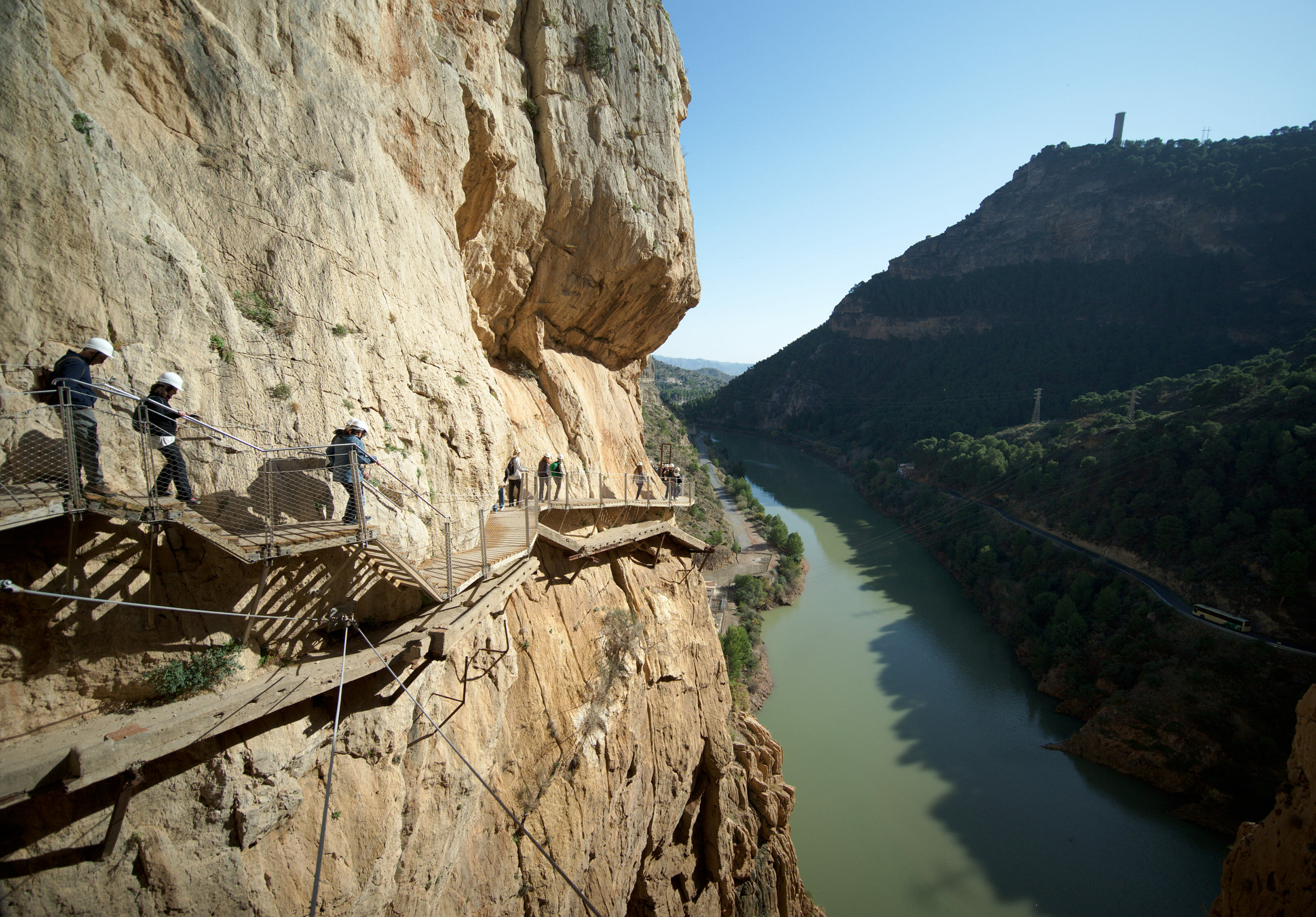
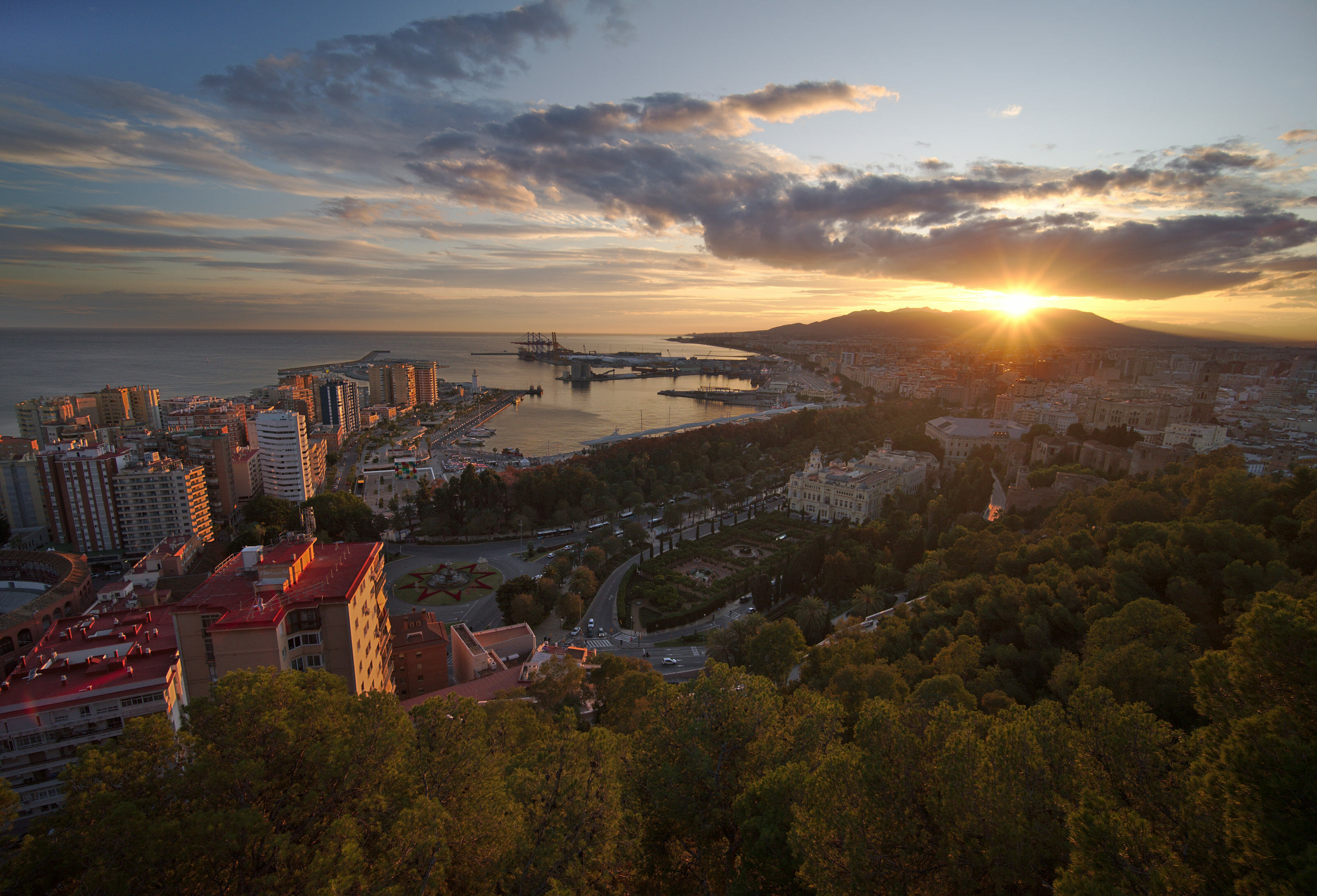
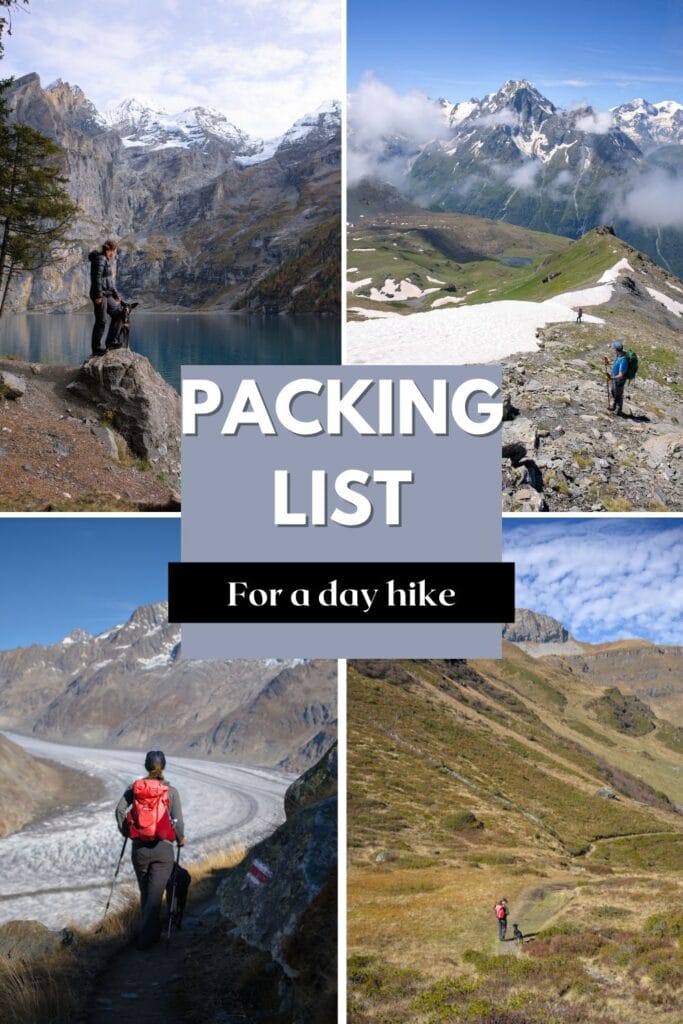
Join the discussion